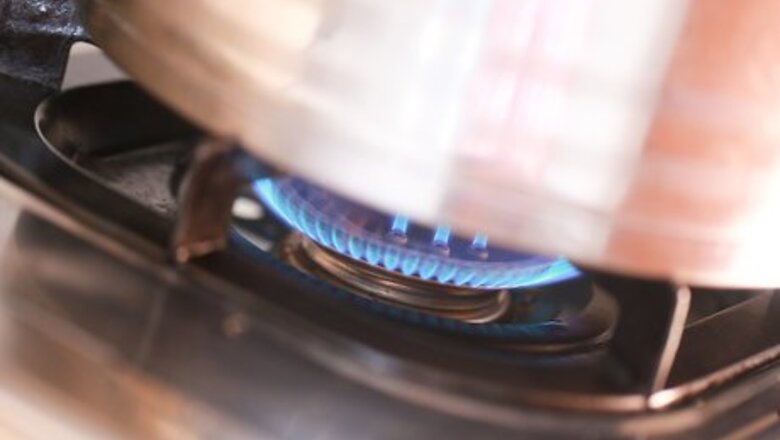
views
Method One: Blanching and Peeling

Bring a saucepan of water to a steady boil. Fill a small saucepan halfway with water. Set the saucepan on the stove over high heat and allow the water to reach a rolling boil. Meanwhile, prepare an ice bath. Add about 1 cup (250 ml) of ice to a medium mixing bowl, then fill the bowl halfway with cold water. Allow the ice to cool down the temperature even further as you work on the remaining steps.
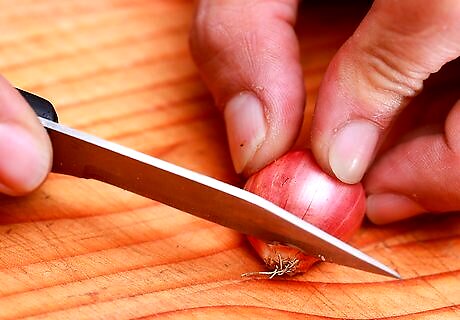
Slice off the root end. Use a sharp knife to slice the root end off each cipollini onion. If any of the skin starts peeling away when you remove the root, use your fingers to peel off as much as possible. At this point, you do not need to worry about removing any skin that does not lift off the onion on its own. Note the difference between the root end and the stem end. The stem end will be marked with a cluster of thin, paper-like skin extending past the top of the onion. The root end will have a thick root that is visible above the skin layer of the onion. For this method and this step, you only need to remove the root end.

Boil the onions. Place the cipollini onions in the boiling water and keep them there for two to three minutes. You'll only need to boil the onions enough to loosen the peel from the sides of the top edible layer. If you keep the onions in the boiling water for more than three minutes, they onions themselves may start cooking and become soft. Do not cover the saucepan as you boil the onions.
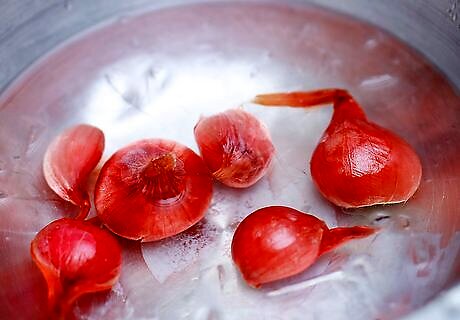
Transfer the onions to an ice bath. Use a slotted spoon to remove the cipollini onions out of the boiling water. Quickly dunk them into your prepared ice bath and keep the onions there for two to three minutes—the same amount of time you used when blanching the onions. If you do not have a slotted spoon, you could also drain the water by pouring the contents of the saucepan through a colander or sieve.
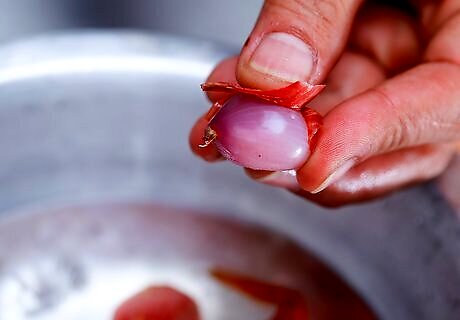
Squeeze the onions out of their peels. Grab each cooled onion at its stem side. Squeeze the papery peel, pushing up against the onion as you work. The cipollini onion should gradually pop out of the skin as you push. Repeat this step as many times as needed until you remove all the skins off all the onions. As you squeeze the onions out of their peels, make sure that you direct them toward a bowl or container that you can catch them in.
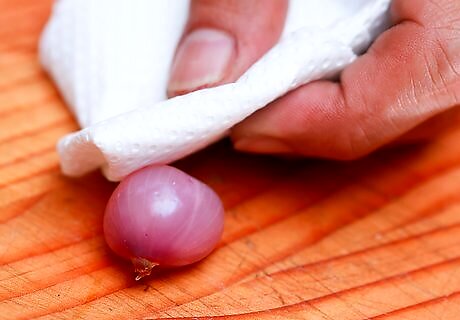
Pat dry. If any moisture remains on the surface of the onions, wipe it off using clean paper towels. This step completes the process.
Method Two: Soaking and Peeling
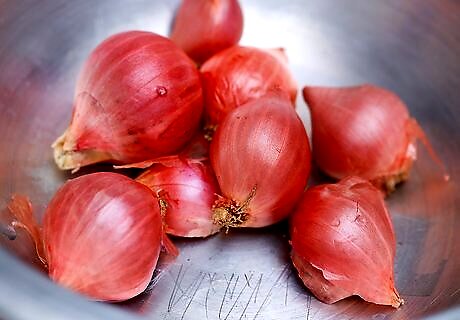
Place the onions in a large bowl. Stack all of the cipollini onions in a large, heat-resistant mixing bowl. Make sure that there is enough empty space at the top of the bowl for 1 inch (2.5 cm) or so of water. Make sure that the bowl you use can withstand extremely hot temperatures. Most glass, metal, and thick plastic bowls are safe, but some thin plastic bowl can start to weaken or melt when exposed to high heat. Styrofoam should not be used. Also note that metal and glass bowls will become very hot during this process, so if you use a metal or glass mixing bowl, you may need to handle it with oven mitts.
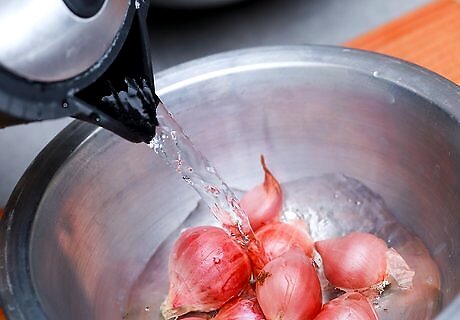
Boil water. Fill a kettle or small saucepan with enough water to cover the onions. Place it on the stove over high heat, keeping it there until the water reaches a rolling boil. Boiling the water in a microwave is not recommended since the water can super-heat, causing its container to burst apart. If you do boil the water in your microwave, though, keep it in a microwave-safe dish and place a non-metal chopstick or spoon in the dish to break the surface tension. Heat the water in brief intervals of 30 seconds or less until it reaches 212 degrees Fahrenheit (100 degrees Celsius).

Pour the water over the onions. Allow the onions to sit in the hot water for two to three minutes. Make sure that all of the onions are completely submerged. The hot water should help loosen the skin, making it easier to remove from the onion. The fact that the water is no longer actively boiling reduces the risk of accidentally cooking the onions, however, which is why many prefer this method over the blanching method.

Drain. Pour the contents of the bowl through a colander to drain the water. Return the onions to the bowl. Use clean, dry paper towels to dry both the onions and bowl after you drain the water. Alternatively, you could scoop the onions out of the water with a slotted spoon. Place them on a clean cutting board when done.
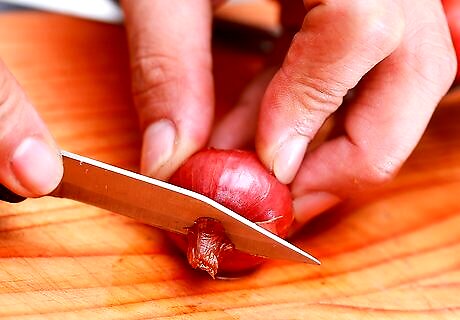
Cut off both ends. Use a sharp knife to cut a thin slice from both the stem and root end of each onion. As you cut off either end, you will likely notice some of the skin peeling away with the slice of onion you're removing. Use your fingers to peel off as much of this attached skin as possible since it will still be the easiest to remove.

Peel away the exposed skin. At this point, the remaining skin should be loose enough to grab and peel away with your fingers. Continue doing so until all of the skin has been removed from all of the onions. If you need a little extra help, you can lift the top of the skin off using the tip of your knife. After loosening the edge of one section of skin, grab this edge with your fingers and peel it off. The process will be complete at the completion of this step.
Method Three: Cutting and Peeling

Peel away a strip of skin. Slide a small, sharp paring knife underneath a section of papery skin at the stem end of each onion. Glide the knife down that strip of skin, peeling the strip off from stem to root. Recognize the difference between the stem end and the root end. You should notice a cluster of papery skin extending past the top of the top of the actual onion. That end is the stem end. The root end, on the other hand, has a tough cluster of root that grows on top of the skin at the bottom of the onion. Unlike the other two methods, this method does not involve any hot water.

Repeat as needed. Continue lifting and peeling away small strips of peel from the onion using your paring knife. Repeat this initial step as often as needed until the entire peel has been removed. Since the papery skin is so thin, you might have difficulty grasping it and removing it by hand. For most people, using a knife will be easier than using your fingers, but if you have difficulty maneuvering the knife, try using your fingers, anyway.
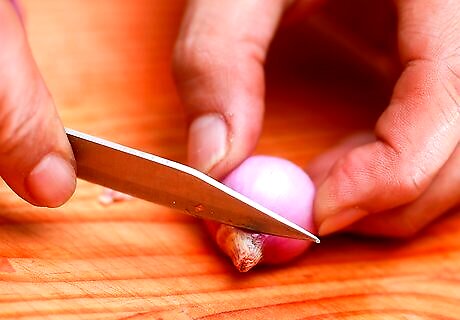
Cut off both ends. Use a sharp knife to cut off a small slice from both the root end and the stem end of each cipollini onion. The stem end and root end are tough and flavorless, so you will generally want to remove them before preparing the onions. The process is finished at the completion of this step.


















Comments
0 comment